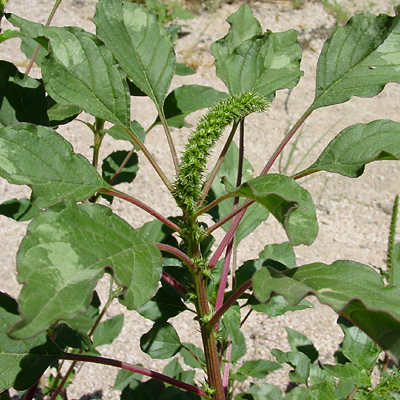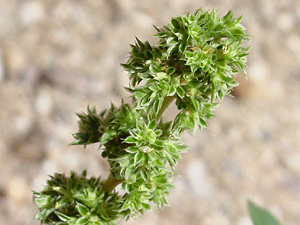Amaranthus palmeri – Carelessweed


Plant Name
Scientific Name: Amaranthus palmeri
Common Names: Carelessweed, Palmer Amaranth, Palmer's Amaranth
Plant Characteristics
Duration: Annual
Growth Habit: Herb/Forb
Arizona Native Status: Native
Habitat: Desert, Upland, Riparian
Flower Color: Green
Flowering Season: Summer, Fall
Height: To 6 feet (1.8 m) tall, but usually less
Description: The flowers have 5 sepals and lanceolate, spine-tipped bracts. The flowers are both borne in the leaf axils and densely clustered on long, thin, often drooping terminal flower spikes. The central, terminal inflorescence is up to 18 inches (46 cm) long and is noticeably longer than the lateral flower spikes. The seeds are shiny, red-brown in color, and tiny, less than 1/16 inch (~1 mm) long. The leaves are simple, green, alternate, hairless, petiolate, egg-shaped to lance-shaped, and often variegated with a horizontal band of silver-green. The stems are erect, branched, and usually reddish in color.
These plants are often found growing in fields, along roadsides, in drainage areas, and along desert washes. The spine-tipped flower bracts are prickly (especially when dry) and can scratch bare skin. Do not walk through a dense patch of dried Carelessweed while wearing shorts.
Special Characteristics
Allergenic – The male flowers have highly allergenic pollen.
Edible – When cooked, the spinach-like leaves and small seeds are edible and nutritious. Birds and mammals also eat the plants and seeds. Warning: This plant can concentrate potentially harmful levels of nitrates in its leaves if grown in nitrogen-rich soil. Do not eat this plant if it's grown in fertilized soil or in soil that receives any agricultural runoff.
Classification
Kingdom: Plantae Plants
Subkingdom: Tracheobionta Vascular plants
Superdivision: Spermatophyta Seed plants
Division: Magnoliophyta Plants
Class: Magnoliopsida Dicotyledons
Subclass: Caryophyllidae
Order: Caryophyllales
Family: Amaranthaceae Amaranth family
Genus: Amaranthus L. – pigweed
Species: Amaranthus palmeri S. Watson – carelessweed
RETURN TO SPECIES LIST |
Your support can make these plans a reality. |
 |
Help Tumamoc extend its timeline throughout the 21st century and beyond. |
| Tumamoc is managed by the University of Arizona College of Science and Pima County, Arizona. |